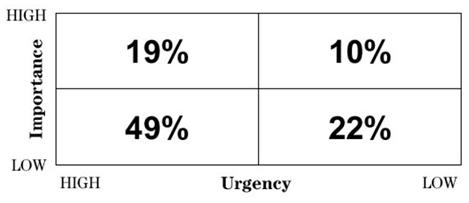
Most of us aspire to better manage our time but how can we do this practically? One way is to consider using a grid such as the one shown below, which puts Importance on one scale and Urgency on another and, by doing so, creates a four-quadrant grid. The numbers in each of the four resulting quadrants below are from a very large-scale research study carried out a few years ago, which showed how much time people spent on average on work tasks in each quadrant. These results are broadly indicative and suggest that we should be very worried about the time spent in doing tasks that are low importance and low urgency (22%) and even the time spent in doing tasks that are high in urgency but nonetheless low in importance (49%).

In looking to use a chart such as this in our own lives, let’s consider the two scales: importance (simply how important is the activity?) and urgency (does this activity need immediate attention or can it wait?).
Eliminate
The low urgency and low importance quadrant is in the bottom right of the chart. In this case, the people in the study spent 22% of their time engaged in activity that was neither urgent nor important (but note that “low” does not mean “no”, so there may be things that are only of limited importance here, like opening junk e-mails, for example). Tasks in this quadrant are a candidate for eliminating as much as possible.
Minimize
The low importance and high urgency quadrant is in the bottom left part of the chart, and here we see the bulk of daily activity–49%, or half of our time being spent here. This is daily “fire-fighting” we all encounter—phone calls, email, visitors wanting to chat, etc. Experts say that we can generally halve the amount of time we spend in this quadrant by lessening or eliminating many of these tasks. Tasks in this quadrant are a candidate for minimizing as much as possible.
Plan
The low urgency and high importance quadrant has the least amount of time represented – only 10%. These activities are often people-oriented in some way -networking, relationship-building and the like. Here, we need to think about how much time we would LIKE to devote to this area as it may be that time spent in the two quadrants above are lessening a person’s ability to do the more important work or projects in this quadrant. Tasks in this quadrant are a candidate for planning as much as possible.
Manage or control
The high importance and high urgency quadrant has nearly 20%. This is the most challenging area to deal with and often includes tasks such as significant crises, important meetings and other higher-level demands on our time. The remedy for these activities is to manage them carefully and consider whether they can be planned better, and thus moved into the Low Urgency and High Importance category above. Tasks in this quadrant are a candidate for managing or controlling as much as possible.
Summary
Managing our time more effectively will always be a uniquely individual task. However, by using the importance and urgency grid and first estimating how much personal time we spend in each quadrant, we may be able to give ourselves a better “route-map” for future change.
Related Resources



Comment here